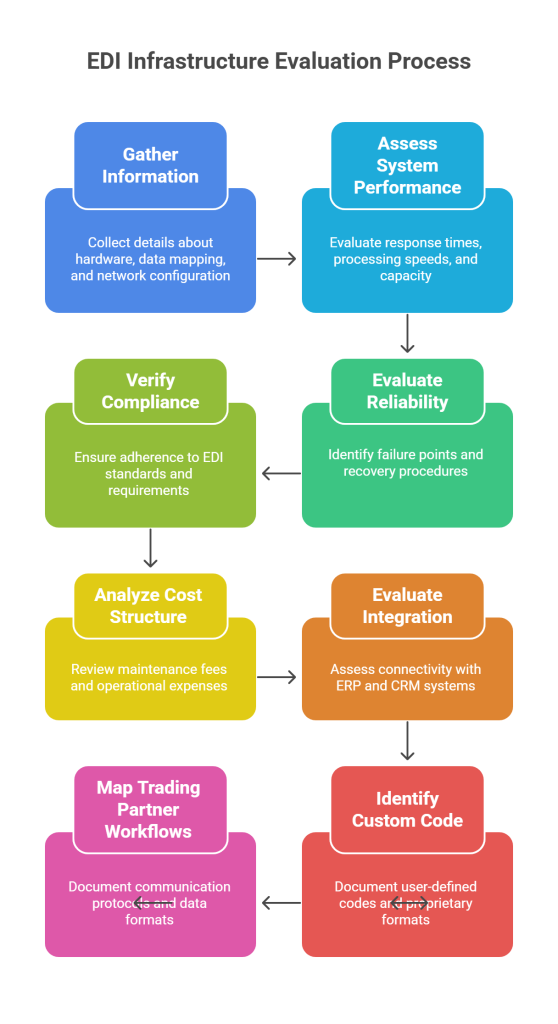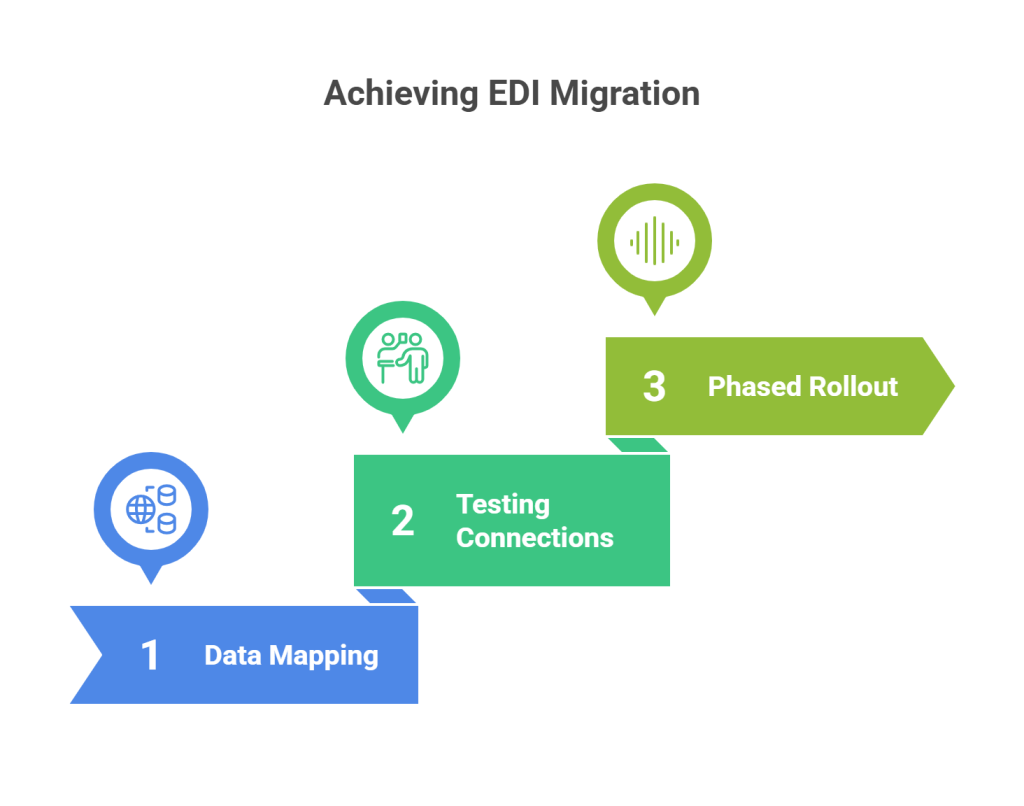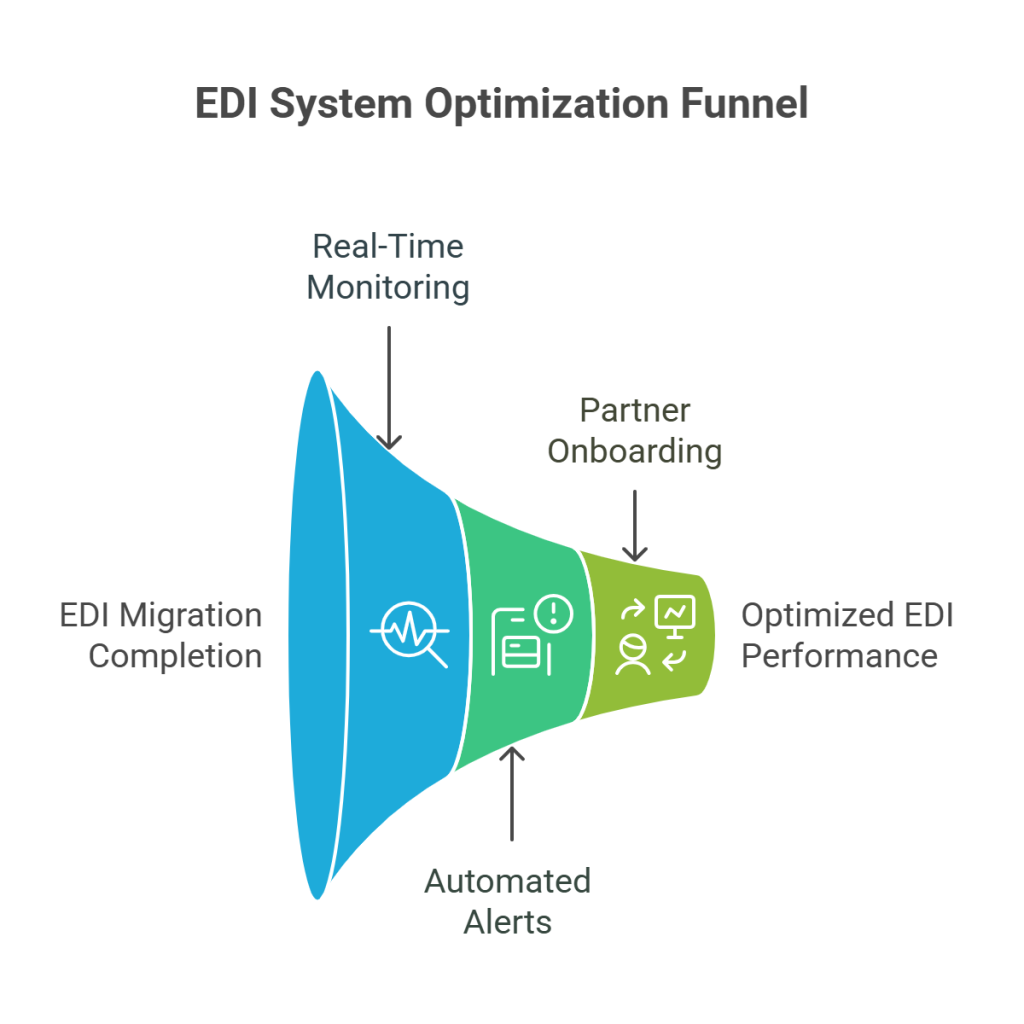Introduction
Did you know that legacy technologies still hinder 88% of organizations? While only 12% of companies have adopted EDI migration to a new modern system or plan to adopt a digital-first business strategy, many businesses still rely on EDI systems designed decades ago.
This disconnect creates serious operational challenges. Legacy EDI systems often impede information flow throughout an organization and become more of an obstacle as they age. If you’re experiencing system slowdowns, inefficiencies, or difficulty integrating with modern technology, it might be time to consider EDI migration.
In this comprehensive guide, we’ll explore how to navigate the journey from outdated EDI solutions to a modern EDI platform. We’ll help you identify limitations in your legacy systems, evaluate your current infrastructure, create a robust migration strategy for your legacy systems, and execute your migration plan effectively. With the right approach, upgrading your EDI system can improve both operational efficiency and your ability to meet evolving customer and trading partner needs.
Identifying Legacy EDI Limitations in Your Business
The aging EDI systems in many organizations have become significant operational bottlenecks. As business needs evolve, these legacy systems increasingly struggle to keep pace with modern requirements. According to research, the average cost of operating and maintaining just one legacy system is approximately USD 30.00M. Let’s examine the four critical limitations that might be holding your business back.

Outdated Protocols and Hardware Dependencies
Legacy EDI systems often rely on outdated protocols that limit their compatibility with modern technologies. These aging systems frequently experience scalability issues, struggling to handle growing data volumes and adapt to changing business processes. Moreover, they frequently depend on specialized hardware that’s becoming increasingly difficult to source and maintain.
Many businesses continue using EDI systems designed decades ago, primarily because the perceived complexity of migration creates hesitation. Furthermore, these legacy systems typically employ outdated security protocols, making them more vulnerable to data breaches, hacks, and fraud. The technical limitations become increasingly apparent through poor integration options, minimal support for modern standards, and inadequate security measures.
High Maintenance Costs and Vendor Lock-in
Maintaining legacy EDI systems drains both financial and human resources. Businesses often find themselves trapped in relationships with outdated EDI providers due to historical reasons, departmental preferences, or acquisitions. One of the most common indicators that it’s time to consider migration is steadily increasing costs without corresponding improvements in service or capabilities.
Organizations that switched EDI providers reported an average cost reduction of 30% while maintaining or improving service levels. Additionally, a Total Economic Forum study by Forrester showed that retiring old legacy systems could reduce hardware and operational running costs by 65%.
Vendor lock-in creates further complications as companies become overly reliant on specific software providers. This dependency often leads to escalating costs, diminished performance, and increased security vulnerabilities over time. The central pain point is vulnerability to any changes applied by providers, including dramatic price increases, since the high switching costs deter customers from changing vendors.
Limited Integration with ERP and CRM Systems
One of the biggest pitfalls in legacy EDI implementations is data duplication between systems. Most EDI solutions exist outside of the ERP, forcing businesses to maintain data in two places: the ERP and the EDI software. This creates room for discrepancies that often aren’t obvious until a trade partner rejects an order or issues a chargeback, which can cost as much as USD 500.00 per sales order.
Legacy EDI systems frequently struggle with integration challenges because:
- Data must undergo multiple translation steps, increasing complexity and chances for errors
- Most systems lack validation logic to check for blank values or incorrect formats
- Users must log into separate portals to monitor errors, delaying issue resolution
Lack of Real-Time Visibility and Reporting
Legacy EDI systems don’t provide real-time insights, making it difficult to track orders or identify potential issues. Instead, businesses are forced to rely on outdated reports or sift through scattered data just to get a clear picture of what’s happening. Without instant access to transaction details, delays and disruptions go unnoticed until they become bigger problems.
This lack of visibility and control over data flows makes it harder to monitor EDI processes and identify problems when they arise. Consequently, users can’t track transaction statuses effectively, creating inefficiencies that make it difficult to respond quickly to customer inquiries and supply chain challenges.
By recognizing these limitations in your current EDI infrastructure, you’ll be better positioned to develop an effective migration strategy that addresses your specific business needs. The next step involves thoroughly evaluating your existing system to create a solid foundation for your migration journey.
Evaluating Your Current EDI Infrastructure

Before embarking on your EDI migration journey, a thorough evaluation of your existing infrastructure is essential. This critical step helps identify gaps, opportunities, and potential challenges that might impact your migration path. A structured assessment approach ensures nothing gets overlooked during your legacy system migration.
- Checklist for Legacy System Assessment
- System Performance
- Reliability
- Compliance
- Cost Structure
- Integration Capabilities
2. Identifying Custom Code and Proprietary Formats
3. Mapping Existing Trading Partner Workflows
- Direct mapping
- Canonical mapping
Checklist for Legacy System Assessment
Initially, gather comprehensive information about your current EDI infrastructure. This includes details about hardware components, data-mapping processes, network configuration, and any performance concerns or known problems. By having this information ready, you can provide a complete picture of your system, enabling a more tailored assessment.
Your evaluation should examine these key aspects:
- System Performance: Assess response times, transaction processing speeds, and capacity limitations
- Reliability: Identify failure points, downtime frequency, and recovery procedures
- Compliance: Verify adherence to current EDI standards and trading partner requirements
- Cost Structure: Analyze maintenance fees, support costs, and operational expenses
- Integration Capabilities: Evaluate how well your EDI system connects with ERP, CRM, and other business applications
“Can your legacy EDI tool offer improved visibility and greater simplicity? Can it connect to a growing list of critical endpoints or accommodate upgraded security protocols?”. These questions help determine if your current system meets both present and future business needs.
Identifying Custom Code and Proprietary Formats
Proprietary standards represent a significant challenge during EDI migration. These formats are “developed and owned by a specific company or organization” and “not publicly available”. They typically operate within closed ecosystems between specific partners who have agreed to use the same standard.
Custom in-house software often links EDI with back-end systems like ERP or accounting platforms. Although once common, this approach proves “quite expensive and complex”. When evaluating your infrastructure, document:
- User-defined codes (UDCs) specific to your system
- Custom transaction set codes and their purposes
- Proprietary data formats requiring special handling
- Custom security implementations
Remember that proprietary standards can create vendor lock-in, making it difficult to switch to other solutions or partners in the future”. Essentially, identifying these custom elements helps determine whether to preserve, convert, or replace them during migration.
Mapping Existing Trading Partner Workflows
Trading partner connections represent some of the most valuable—yet complex—components of your EDI infrastructure. For each trading partner, document their communication protocols, data formats, and transaction requirements.
When mapping workflows, distinguish between communication and conversion processes. The communication part involves exchange parameters (IP/port/certificates), while conversion deals with translating data between formats. Both aspects must be thoroughly documented before migration.
Consider whether you use direct (1:1) or canonical (indirect) mapping:
- Direct mapping: Creates a single translation between trading partners
- Canonical mapping: Uses standardized formats that simplify complex transactions
Practically speaking, placing trading partner contact information in your assessment is invaluable. Many successful migrations involve “asking them to put us on as a contact as their EDI support”, ensuring smooth communication throughout the transition process.
Switch to Commport EDI Solutions for a painless migration experience. Their modern EDI solutions fit businesses of all sizes, offering integrated EDI, cloud EDI, and managed EDI services that eliminate the headaches of outdated systems while preserving your critical business connections.
By thoroughly evaluating your current infrastructure, you create the foundation for a successful migration strategy. This assessment provides the blueprint needed to determine whether replatforming, rehosting, or rebuilding represents your best path forward
Creating a Legacy System Migration Strategy
After completing your system evaluation, crafting a strategic migration plan becomes your next critical step. A well-structured strategy prevents costly disruptions while ensuring your business achieves maximum value from your EDI migration

Defining Migration Goals and Success Metrics
Successful EDI migrations begin with clearly defined objectives. First, establish specific goals such as achieving compliance with evolving legal requirements for e-invoicing or eliminating technical bottlenecks in your current system. Next, determine how you’ll measure success—whether through reduced transaction processing times, decreased error rates, or improved customer satisfaction metrics.
Your strategy should include:
- Full definition of scope and migration priorities
- Required resources and budget allocations
- Key milestones with realistic timelines
- Measurable outcomes that align with business objectives
Remember to engage all relevant stakeholders in this process, particularly IT teams, business units responsible for finance/accounting, and supply chain process owners. Early involvement creates buy-in and helps motivate teams through the change process.
Choosing Between Deplatforming, Rehosting, or Rebuilding
The migration strategy you select significantly impacts implementation complexity and outcomes. Consider these primary approaches:
Rehosting (lift-and-shift): This strategy involves moving your EDI applications to a new environment without making significant architectural changes. Ideal when you need to migrate quickly with minimal disruption, rehosting helps you scale applications without implementing cloud optimizations that could save time or money.
Replatforming (lift-tinker-shift): This middle-ground approach moves your EDI solution to a new environment while introducing some optimization. For instance, you might replatform a database to Amazon RDS while preserving most application functionality. This strategy avoids a complete overhaul yet takes advantage of modern infrastructure benefits.
Rebuilding/Refactoring: Though offering the highest potential return, this approach requires rewriting applications to fully leverage cloud capabilities. However, as noted by AWS, “refactor is not recommended for large migrations because it involves modernizing the application during migration,” making it “the most complex of the migration strategies.”
Risk Assessment and Contingency Planning
Every migration carries inherent risks. Conduct a comprehensive risk assessment, identifying both technical issues (system compatibility, data transformation challenges) and operational concerns (process disruptions, data security vulnerabilities). Analyze each risk’s likelihood and potential impact to prioritize mitigation efforts effectively.
With Built in VAN and Translation Services. Rest Assured, You Can Start Exchanging Standardized EDI Documents Whenever and Wherever You do Business.
Establish clear roles and responsibilities among stakeholders to minimize misunderstandings and conflicts. Finally, develop contingency plans for potential challenges, especially for critical business processes that cannot tolerate downtime. This preparation ensures you can respond rapidly to unexpected issues throughout your EDI migration journey.
Executing the EDI Migration Plan
With your migration strategy defined, the focus shifts to implementation tools and methodologies. The execution phase transforms your well-crafted plan into operational reality, typically requiring specialized resources to ensure a smooth transition.

Data Mapping and Transformation Tools
Effective data mapping sits at the heart of successful EDI migration. This process involves transforming data from one format to another so the recipient’s system can process and understand it. Modern EDI mapping tools provide visual interfaces that break down EDI messages into segments, elements, and subelements, making complex transformations more manageable.
These sophisticated tools support numerous translation types, including:
- EDI to XML, JSON, and databases
- EDI to Excel and flat files
- EDI to other EDI formats
When selecting mapping software, prioritize conversion capabilities between larger file sizes (such as X12) and lightweight formats like JSON that your ERP can process more efficiently. Additionally, look for tools that allow custom rule implementation to accommodate your trading partners’ distinct requirements.
Testing and Validating Trading Partner Connections
Before full implementation, thorough testing minimizes the risk of costly disruptions. The industry average for new trading partner setups is over 8 weeks, yet specialized EDI service providers can reduce this to just 5 business days.
Effective EDI testing should include:
Connectivity testing ensures communication links between trading partners function properly. Functional testing verifies that all required data elements are present, correctly formatted, and accurately mapped according to EDI standards. Subsequently, performance testing evaluates your system’s ability to handle large transaction volumes without degradation.
At this point, partner testing becomes essential. Collaborate with key business partners to perform joint testing that verifies electronic documents flow seamlessly between your respective back-end systems.
Phased Rollout vs Big Bang Approach
The implementation method you choose significantly impacts project risk and timeline. A big bang approach delivers shorter implementation timelines and cost savings from less time maintaining dual systems. Nevertheless, this method carries greater risk as every issue becomes immediately visible to all stakeholders.
Conversely, phased implementation allows for earlier ROI realization from initial populations and provides more time for parallel testing. This approach is particularly valuable for large, complex organizations seeking some early business benefits with minimal risk. The phased method can target early adopters who may be more understanding of initial bugs or issues.
For most EDI migrations, a phased approach with carefully planned waves offers the optimal balance between risk mitigation and business continuity.
Post-Migration Optimization and Monitoring
Once your EDI migration is complete, the journey has only just begun. Continuous monitoring and optimization remain vital to maintain peak system performance after transitioning to your modern EDI platform.

Real-Time Transaction Monitoring Dashboards
Successful EDI operations require comprehensive visibility—just as a car dashboard displays crucial information, your EDI dashboard should function as your company’s “B2B messaging cockpit.” An effective dashboard provides immediate insights without requiring users to reload pages or navigate through multiple screens. The best monitoring solutions include:
- Visual cues with distinct colors highlighting anomalies or errors
- Progress bars and summary counters showing transaction processing statistics
- Pie graphs displaying document types processed (invoices, purchase orders)
- Performance metrics tracking average processing speeds and acknowledgment latency
These visualization tools enable your team to identify potential issues immediately rather than discovering problems after they’ve escalated. Proper dashboards also allow user permission controls to manage internal teams efficiently, providing transparency about which users are currently active.
Automated Alerts for Failed Transactions
While integrated EDI significantly improves accuracy, no system is entirely bulletproof. Errors can originate from trading partners, data entry personnel, or computer glitches. Without proper notification systems, these errors can compound exponentially.
Auto-notification tools address this vulnerability by:
- Sending immediate alerts via email or mobile devices when errors occur
- Categorizing alerts based on severity (critical, warning, informational)
- Delivering multichannel notifications based on user preferences
- Pinpointing error causes to expedite resolution
Most modern EDI systems can be configured for automated alerts, helping protect your business from costly disruptions. For instance, if inbound data fails to move into your sales order module, targeted notifications can immediately alert the appropriate personnel.
Continuous Partner Onboarding and Support
Post-migration support proves crucial for long-term success. After transitioning to your new EDI system, the post-go-live window demands extra vigilance. Develop strategies for:
- Monitoring key metrics like transaction volume, error rates, and system performance
- Providing refresher training and knowledge resources for users
- Assigning dedicated personnel to resolve trading partner issues
- Conducting regular reviews to identify improvement opportunities
Regular updates are essential for maintaining optimal system performance, preventing a gradual decline in both performance and security. By proactively supporting users and trading partners even after implementation, you’ll minimize disruptions and maximize the value of your EDI migration investment.
Conclusion
Your migration journey begins with honest assessment. Examining your current infrastructure provides the foundation for success, especially when identifying custom code and mapping trading partner workflows. This evaluation phase, though sometimes overlooked, ultimately determines whether your migration succeeds or struggles.
The migration strategy you select—whether rehosting, deplatforming, or rebuilding—must align with your specific business requirements. Each approach offers distinct advantages depending on your timeline, budget constraints, and technical needs. Most organizations benefit from the balanced approach of phased implementation, which minimizes disruption while allowing teams to address issues before they affect your entire operation.
After completing implementation, your focus must shift toward optimization. Real-time monitoring dashboards, automated alerts, and continuous partner support transform your EDI system from a mere utility into a strategic business asset. These post-migration activities ensure your investment continues delivering value long after the initial transition.
EDI migration represents more than a technical upgrade, a business transformation that affects everything from daily operations to strategic partnerships. Organizations that successfully navigate this transition gain significant competitive advantages through improved efficiency, reduced costs, and enhanced trading partner relationships. Although the journey may seem daunting, the results deliver lasting value that positions your business for continued success in an increasingly digital marketplace.
Commport EDI Solutions
Need Help? Download: Commport's EDI Buyers Guide
Unlock the full potential of your supply chain with our comprehensive EDI Buyer's Guide — your first step towards seamless, efficient, and error-free transactions
Frequently Asked Questions
Legacy EDI systems often have outdated protocols, high maintenance costs, limited integration with modern business systems, and lack real-time visibility. These limitations can lead to inefficiencies, increased expenses, and difficulties in adapting to evolving business needs.
To evaluate your EDI infrastructure, create a checklist for system assessment, identify custom code and proprietary formats, and map existing trading partner workflows. This process helps you understand your system’s performance, reliability, compliance, and integration capabilities.
The main approaches to EDI migration are rehosting (lift-and-shift), deplatforming (lift-tinker-shift), and rebuilding/refactoring. Each approach has its own benefits and challenges, and the choice depends on your specific business needs, timeline, and resources.
Testing is crucial during EDI migration. It should include connectivity testing, functional testing, and performance testing. Collaborating with key business partners for joint testing ensures that electronic documents flow seamlessly between systems, minimizing the risk of costly disruptions.
After migration, focus on post-migration optimization and monitoring. Implement real-time transaction monitoring dashboards, set up automated alerts for failed transactions, and provide continuous partner onboarding and support. These measures help maintain peak system performance and maximize the value of your EDI migration investment.





